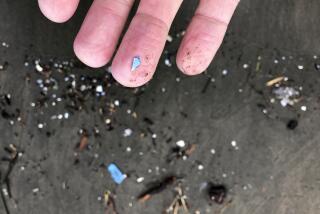Hormone Study Finds No Firm Answers
After four years of review, a prominent national panel of scientists has concluded that the human toll from hormone-altering chemicals in the environment remains shrouded in scientific doubt and controversy, and credible answers could take another generation of research.
Pesticides and other pollutants that mimic estrogen or block male hormones do seem to be feminizing fish, birds and other creatures, according to the long-awaited report unveiled Tuesday by a committee of the National Academy of Sciences.
The panel also concluded that the artificial hormones are apparently suppressing immune systems and causing neurological damage in animals.
But after some bruising battles behind the scenes, the 16 scientists, including two who work with chemical companies and several viewed favorably by environmentalists, reached no conclusion on whether hormone-mimicking pollutants are harming people too. They decided there was so little data and so many lingering questions that it is impossible to tell.
Used in pesticides, plastics, detergents and industrial compounds, chemicals called “endocrine disrupters” are ubiquitous. Because of the serious implications for human fertility and health, and because the compounds are critical to a wide array of activities, hormone disruption is one of the most hotly disputed environmental issues of modern times.
“There’s no question that some of these substances called endocrine disrupters have had, and continue to have, major effects on wildlife,” said panel Chairman Ernst Knobil, a reproductive endocrinologist at the University of Texas at Houston Medical School.
For human beings, Knobil said, harm from hormone mimics is absolutely a viable theory, “but we really cannot be sure. It’s a difficult subject, not conducive to easy answers. There’s mountains of [data], and it’s very confusing. The evidence is simply incomplete.”
The scientists began their review in 1995--the report was two years overdue--and in recent months, they battled among themselves over how to phrase their uncertainty about potential human dangers.
The report includes no definitive statements on the effect that chemicals that mimic hormones could have on humans. Some researchers have raised the possibility that the chemicals are linked to declining sperm counts in adult men, autoimmune diseases and learning disabilities of children exposed in the womb.
Finding answers, the committee said, would require studying a large group of people for an entire generation--following them from conception through adulthood to see what they are exposed to and how healthy they wind up.
Frederick vom Saal, who was among the committee members most inclined to accept the possibility that humans are being harmed, said the report’s “take-home” message is: “While we don’t have a lot of human evidence yet, we’re seeing wildlife populations affected and animal research showing these chemicals can alter development. We need a higher level of concern and commitment by the government to find out about the relationship of these chemicals to human disease.”
Stephen Safe, a Texas A & M scientist and committee member who believes that endocrine disrupters pose no serious threat to human health, said he agreed that many questions still need to be researched. He stressed, however, that the report lays to rest some key controversies, especially the suggestion that there has been a worldwide decline in sperm counts.
The panel said there was no evidence of a global decline in sperm counts, although some evidence points to declines in certain regions, particularly Europe. Whether those declines are linked to pollution is unknown, the report said.
Representatives of chemical and farm industries had no public reaction Tuesday. In the past, they have stressed the lack of data showing human harm and called for further research and screening of chemicals.
Environmental activists were disappointed that the report was not worded more strongly.
“It’s a little schizophrenic. It’s so heavily balanced that it borders on not saying anything,” said Peter de Fur, an environmental advocate and professor of environmental studies in Virginia. “I think there’s more human health evidence than they put in the executive summary.”
For several years, some scientists have suspected that an unborn child’s exposure to hormone-mimicking pollutants could cause reproductive diseases and disorders. Hormones control development of a child’s brain and immune system, and exposure during fetal development might alter intelligence and behavior and weaken defenses to infectious disease or trigger autoimmune disease.
Studying that possibility is difficult, partly because decades elapse between possible prenatal exposure to a chemical and the onset of a disease, such as breast or testicular cancer.
The scientists wrote that current research does not support a link between adult exposure to pesticides and breast cancer. But they said no research has been done to tell if exposure earlier in life--during fetal development--could be causing cancer.
With respect to neurological damage, the scientists said there is evidence that a mother’s exposure to high concentrations of some hormone pollutants causes cognitive problems in her baby. But the importance of this also needs to be explored from womb to adulthood, they said.
An initial draft of the 700-page report included language downplaying risks to people, concluding there is no evidence of human harm. But several members of the panel objected, noting that the lack of evidence in some cases may be caused by a lack of studies.
Louis Guillette, of the University of Florida, who was one of four members who felt most strongly that the early draft downplayed human risks, called the final report “a reasonable compromise,” although he said he would have written it more strongly.
Much of the conflict among the scientists, who specialize in an array of disciplines, focused on how much weight to give animal research. Estrogen and other hormones function essentially the same in every vertebrate creature--from a developing alligator to a human baby.
Recent research has shown hormone harm to many animals, including eagles in the Great Lakes, alligators in Florida, carp in Nevada’s Lake Mead, river otters in the Pacific Northwest and fish in Great Britain. Some wind up infertile with ovarian parts and sperm ducts.
Another problem is that the chemicals under study are so widespread. The federal Environmental Protection Agency is requiring industry to screen at least 15,000 separate chemicals to see if they could be hormone disrupters. Scientists usually try to compare a group of people who have been exposed to a chemical with people who have not been exposed to determine what impact the chemical has had. But nearly everyone on Earth has been exposed to some extent to chemicals that mimic hormones.






